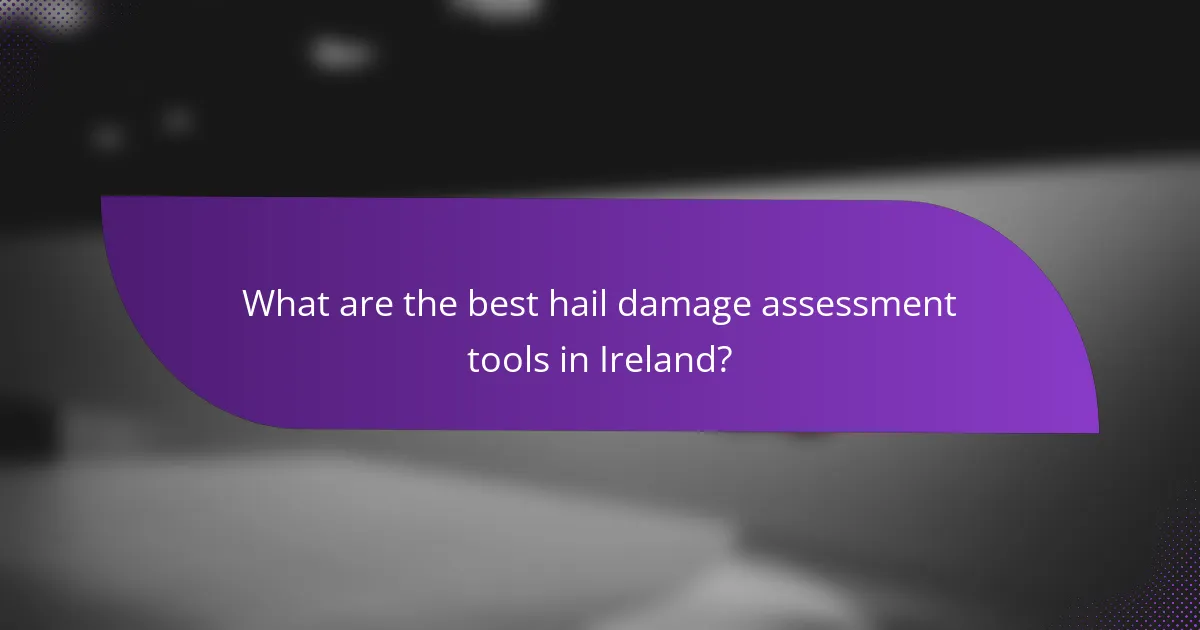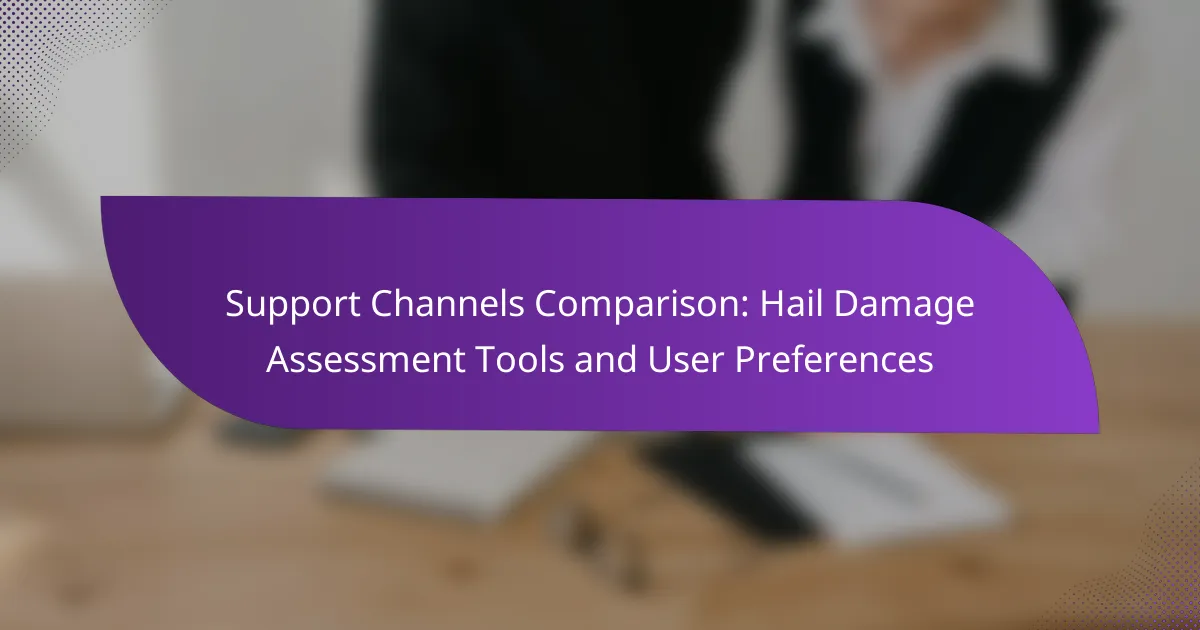This comparison explores the various hail damage assessment tools available in Ireland, highlighting their features and user preferences. By examining real-time data capabilities, ease of use, and pricing models, we aim to provide insights into how these tools assist users in evaluating damage and managing insurance claims effectively.

What are the best hail damage assessment tools in Ireland?
The best hail damage assessment tools in Ireland include various platforms that provide real-time data and analytics on hail events. These tools help users evaluate damage, plan repairs, and make informed decisions regarding insurance claims.
HailTrace
HailTrace is a specialized tool that offers detailed hail impact maps and historical data. It utilizes radar technology to track storms and assess hail size and intensity, making it valuable for contractors and insurance adjusters.
Users can access interactive maps that show hail paths, allowing for precise assessments of affected areas. This tool is particularly useful for professionals needing to estimate repair costs based on hail damage.
AccuWeather
AccuWeather provides comprehensive weather forecasts, including hail predictions. Its radar features allow users to monitor storm developments in real-time, which is crucial for timely damage assessments.
The platform also offers alerts for severe weather, helping users prepare in advance. While it may not focus solely on hail damage, its extensive coverage makes it a reliable resource for general weather-related inquiries.
WeatherBug
WeatherBug delivers real-time weather information, including alerts for hailstorms. Its user-friendly interface allows users to quickly access local weather conditions and forecasts.
This tool is beneficial for homeowners and businesses looking to stay informed about potential hail threats. It includes features like live radar and notifications, which can help users take precautionary measures.
StormGeo
StormGeo offers advanced weather analytics and forecasting services tailored for various industries, including agriculture and insurance. Its hail damage assessment tools provide detailed insights into storm patterns and potential impacts.
Users can leverage this data to make proactive decisions regarding property protection and damage mitigation. The platform is particularly suited for businesses that require in-depth weather analysis for operational planning.
HailMap
HailMap specializes in visualizing hail damage through detailed mapping tools. It provides users with access to historical hail data and storm tracking, which is essential for assessing past events.
This tool is particularly useful for insurance companies and contractors needing to evaluate claims and repair needs. Its user-friendly interface allows for quick navigation and data retrieval, enhancing the assessment process.

How do user preferences influence tool selection?
User preferences significantly influence the selection of hail damage assessment tools by prioritizing features that enhance their experience and effectiveness. Factors such as ease of use, accuracy of assessments, and integration capabilities play crucial roles in determining which tools are favored by users.
Ease of use
Ease of use is a primary consideration for users when selecting hail damage assessment tools. Tools that feature intuitive interfaces and straightforward navigation tend to be preferred, as they reduce the learning curve and allow users to quickly assess damage without extensive training.
For instance, a mobile app that allows users to take photos and automatically generate reports is often more appealing than a complex software requiring manual data entry. Users typically favor tools that streamline the assessment process, saving time and effort.
Accuracy of assessments
Accuracy is critical in hail damage assessments, as it directly impacts insurance claims and repair decisions. Users prefer tools that provide reliable and precise evaluations, minimizing the risk of underestimating or overestimating damage.
Tools that utilize advanced algorithms or machine learning to analyze images and data can enhance accuracy. Users should look for tools that offer validation against industry standards or have a proven track record in real-world scenarios to ensure dependable results.
Integration capabilities
Integration capabilities are essential for users who want seamless workflows between different systems. Tools that can easily connect with existing software, such as customer relationship management (CRM) systems or insurance platforms, are often favored.
For example, a hail damage assessment tool that automatically uploads reports to a user’s CRM can save time and reduce errors. Users should evaluate how well a tool integrates with their current systems, as this can significantly enhance efficiency and data management.

What are the pricing models for hail damage assessment tools?
Hail damage assessment tools typically utilize various pricing models, including subscription-based, pay-per-use, and freemium options. Each model has distinct advantages and considerations that can affect user preferences and overall costs.
Subscription-based pricing
Subscription-based pricing involves users paying a recurring fee, often monthly or annually, to access the assessment tools. This model is beneficial for users who require consistent access to the software, as it often includes regular updates and support.
Costs for subscriptions can vary widely, generally ranging from low tens to several hundred dollars per month, depending on the features offered. Users should assess their usage frequency and the value of included services when considering this model.
Pay-per-use pricing
Pay-per-use pricing charges users based on the number of assessments conducted or the specific features utilized. This model is ideal for those who may only need the tool occasionally, as it allows for flexibility without a long-term commitment.
Pricing typically varies by the type of assessment, with costs often falling within a range of a few dollars to over a hundred dollars per assessment. Users should estimate their potential usage to determine if this model is more cost-effective than a subscription.
Freemium models
Freemium models offer basic features at no cost, with advanced functionalities available through paid upgrades. This approach allows users to try the tool without financial commitment, making it appealing for those new to hail damage assessment.
While the free version may be limited in features, it can still provide valuable insights. Users should evaluate whether the premium features justify the cost based on their specific needs and the potential benefits of enhanced capabilities.

What features should be considered when choosing a hail damage assessment tool?
When selecting a hail damage assessment tool, consider features that enhance accuracy, usability, and accessibility. Key aspects include real-time data updates, a user-friendly interface, and mobile accessibility to ensure efficient assessments and user satisfaction.
Real-time data updates
Real-time data updates are crucial for accurate hail damage assessments, as they provide the latest information on weather conditions and storm patterns. Tools that integrate with weather APIs can offer immediate alerts and updates, helping users make timely decisions. Look for tools that refresh data frequently, ideally every few minutes, to stay ahead of changing conditions.
For example, a tool that updates every 5 minutes can significantly improve assessment accuracy compared to one that updates hourly. This feature is particularly important for insurance adjusters and contractors who need to respond quickly to damage reports.
User-friendly interface
A user-friendly interface is essential for ensuring that all users, regardless of their technical skill, can effectively navigate the assessment tool. Look for intuitive designs that prioritize ease of use, such as clear menus, straightforward navigation, and accessible help features. A well-designed interface can reduce training time and improve overall efficiency.
Consider tools that offer customizable dashboards, allowing users to prioritize the information most relevant to their needs. This personalization can enhance the user experience and streamline the assessment process.
Mobile accessibility
Mobile accessibility allows users to conduct hail damage assessments on-the-go, which is particularly beneficial for field agents and contractors. Tools that are optimized for mobile devices can enable users to capture data, upload images, and communicate findings directly from the site. This flexibility is vital for timely responses to hail damage.
When evaluating mobile accessibility, check for compatibility with various devices and operating systems. A responsive design that adapts to different screen sizes can enhance usability and ensure that users have access to all necessary features, regardless of their location.

How do hail damage assessment tools compare in terms of accuracy?
Hail damage assessment tools vary in accuracy based on their methodologies and data sources. Users should consider the specific metrics and performance of each tool to determine which best meets their needs for reliable assessments.
HailTrace accuracy metrics
HailTrace utilizes advanced radar technology and historical data to provide accurate hail damage assessments. Their accuracy metrics often reflect a high correlation with actual damage reports, typically achieving accuracy rates in the high 80s to low 90s percent range.
When using HailTrace, it is crucial to consider the geographic area and the time frame of the data. For example, rural areas may have less precise data due to fewer reporting stations. Users should cross-reference HailTrace findings with local reports for the best results.
AccuWeather accuracy metrics
AccuWeather offers hail damage assessments based on a combination of meteorological data and predictive modeling. Their accuracy can vary, often landing in the mid to high 70s percent range, depending on the storm’s intensity and the region.
Users should be aware that while AccuWeather provides timely updates, its predictive nature may lead to discrepancies in actual damage assessments. It’s advisable to use AccuWeather in conjunction with other tools for a more comprehensive view.
WeatherBug accuracy metrics
WeatherBug employs a network of weather stations to deliver real-time hail assessments, achieving accuracy rates typically in the low to mid 80s percent range. Their localized data can be particularly useful for urban areas with dense reporting networks.
For optimal use, WeatherBug users should ensure their location settings are accurate and consider the tool’s limitations during extreme weather events, where rapid changes can affect assessment accuracy. Combining WeatherBug data with visual inspections can enhance reliability.

What integrations are available for hail damage assessment tools?
Hail damage assessment tools often integrate with various platforms to enhance their functionality and user experience. Common integrations include insurance management systems, customer relationship management (CRM) software, and data analytics platforms.
Insurance Management Systems
Integrating hail damage assessment tools with insurance management systems streamlines the claims process. This allows adjusters to quickly access damage reports and photos, improving efficiency and accuracy in claims handling.
For example, tools like Xactimate or Symbility can automatically pull data from assessment tools, reducing manual entry and minimizing errors. This integration can lead to faster claim resolutions and improved customer satisfaction.
Customer Relationship Management (CRM) Software
Integrating with CRM software helps track customer interactions and manage follow-ups effectively. This connection allows hail damage assessors to maintain a comprehensive view of client history and preferences, facilitating better service.
Popular CRM platforms like Salesforce or HubSpot can be linked to assessment tools, enabling seamless communication and data sharing. This integration can enhance client relationships and improve retention rates.
Data Analytics Platforms
Data analytics integrations provide valuable insights into hail damage trends and customer behavior. By connecting assessment tools with analytics platforms, users can analyze data patterns to inform decision-making and strategy.
Tools such as Tableau or Google Analytics can visualize hail damage data, helping companies identify high-risk areas or optimize their service offerings. This analytical approach can lead to more targeted marketing and resource allocation.
